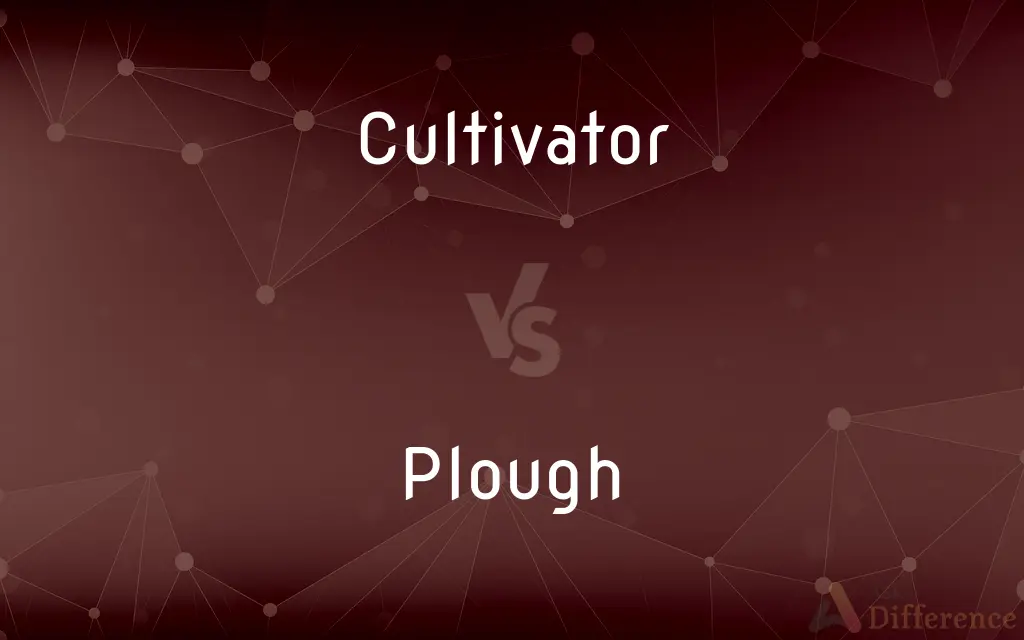Cultivator vs. Plough — What's the Difference?
By Tayyaba Rehman & Urooj Arif — Updated on April 8, 2024
Cultivator is a farming tool used for secondary tillage, stirring and aerating the soil, while Plough is used for primary tillage, turning over the upper layer of soil to prepare for seeding.

Difference Between Cultivator and Plough
Table of Contents
ADVERTISEMENT
Key Differences
Cultivators are designed to mix loose soil, remove weeds, and aerate the soil after it has been plowed and before planting. They come in various forms, including hand tools, tractor-drawn implements, and self-propelled models, suitable for different sizes of land and specific tasks like weed control and soil aeration. Whereas ploughs are heavier, more robust tools intended for breaking up hard soil, turning it over to bury crop residues and weeds, which is a crucial step in preparing a field for planting. The action of ploughing can also help in the aeration of the soil, but its primary purpose is to ready the soil for seeding by creating a fresh soil surface.
While cultivators are used throughout the growing season to maintain soil conditions and control weeds, enabling better water absorption and root growth, ploughs are typically used at the beginning of the planting cycle to create a clean slate for seeds. This distinction highlights the cultivator's role in ongoing field maintenance versus the plough's role in initial field preparation.
Cultivators often have multiple uses, including breaking up soil clumps and incorporating fertilizers into the soil. They are considered a more versatile tool in the farmer's arsenal for maintaining soil health and encouraging plant growth. On the other hand, ploughs have a more singular focus on inverting and cutting furrows in the soil, which can help with pest control and prepare the land for new crops by turning under weeds and previous crop residues.
In terms of impact on soil structure, cultivators are less invasive and designed to preserve soil moisture and reduce erosion by not turning the soil too deeply. This makes them suitable for inter-cropping and precision farming practices. Conversely, ploughs, especially moldboard ploughs, can significantly alter the soil profile and are more likely to lead to soil erosion if not used judiciously, making them less suitable for certain conservation agriculture practices.
Considering technological advancements, modern cultivators can be equipped with GPS and other precision farming tools to target specific rows and plants, minimizing damage to crops and maximizing efficiency in weed control and soil preparation. Whereas modern ploughs have also seen improvements, including variable depth control and better materials for reduced wear and tear, their fundamental design and purpose have remained more consistent over time, focusing on turning the soil for a fresh planting surface.
ADVERTISEMENT
Comparison Chart
Primary Use
Secondary tillage, soil aeration, and weed control.
Primary tillage, turning over and breaking up the soil.
When Used
After ploughing and throughout the growing season.
At the beginning of the planting cycle to prepare the field.
Impact on Soil
Less invasive, preserves soil moisture and structure.
More invasive, can significantly alter soil profile.
Versatility
High, with various uses throughout growing season.
Lower, mainly focused on soil preparation for planting.
Technological Advances
Often equipped with precision farming tools.
Focus on durability and efficiency in turning soil.
Compare with Definitions
Cultivator
Enhances soil conditions for crop growth.
Regular use of a cultivator helped improve soil health over the season.
Plough
A tool for primary tillage, turning over soil.
The farmer ploughed the field to prepare for spring planting.
Cultivator
A farming tool for mixing and aerating soil.
He used a cultivator to prepare the beds for planting.
Plough
Used to bury crop residues and weeds.
Ploughing helped incorporate the previous crop's residues back into the soil.
Cultivator
Used for secondary tillage and weed control.
The cultivator removed the weeds without harming the young plants.
Plough
Essential for initial soil preparation.
They brought out the plough after deciding to convert the meadow into cropland.
Cultivator
Can be manual or mechanized.
She attached the cultivator to the tractor for faster field preparation.
Plough
Can drastically change the soil profile.
The moldboard plough created deep furrows in the field.
Cultivator
Suitable for precision agriculture.
With a GPS-equipped cultivator, they targeted specific areas with high weed growth.
Plough
Less suited for conservation tillage.
To reduce erosion, they limited the use of the plough and opted for no-till methods.
Cultivator
A cultivator is an agricultural equipment used for secondary tillage. One sense of the name refers to frames with teeth (also called shanks) that pierce the soil as they are dragged through it linearly.
Plough
A plough or plow (US; both ) is a farm tool for loosening or turning the soil before sowing seed or planting. Ploughs were traditionally drawn by oxen and horses, but in modern farms are drawn by tractors.
Cultivator
One who cultivates
An inveterate cultivator of beautiful gardens.
A cultivator of valuable corporate contacts.
Plough
A farm implement consisting of a strong blade at the end of a beam, usually hitched to a draft team or motor vehicle and used for breaking up soil and cutting furrows in preparation for sowing.
Cultivator
An implement or machine for loosening the soil and destroying weeds around growing plants.
Plough
An implement or machine designed to move earth, snow, or other material by means of a strong blade.
Cultivator
Any of several devices used to loosen or stir the soil, either to remove weeds or to provide aeration and drainage.
Plough
Plow See Big Dipper.
Cultivator
A person who cultivates.
Plough
To break and turn over (earth) with a plow.
Cultivator
One who cultivates; as, a cultivator of the soil; a cultivator of literature.
Plough
To form (a furrow, for example) with a plow.
Cultivator
An agricultural implement used in the tillage of growing crops, to loosen the surface of the earth and kill the weeds; esp., a triangular frame set with small shares, drawn by a horse and by handles.
Plough
To form furrows in with a plow
Plow a field.
Cultivator
Someone concerned with the science or art or business of cultivating the soil
Plough
To form wrinkles or creases in
His forehead was plowed with lines of stress.
Cultivator
A farm implement used to break up the surface of the soil (for aeration and weed control and conservation of moisture)
Plough
To move or clear (snow, for example) by means of a plow.
Plough
To clear (an area) of snow or other material by means of a plow.
Plough
To make or form with driving force
I plowed my way through the crowd.
Plough
To progress through (water)
Plow the high seas.
Plough
Vulgar Slang To have intercourse with (another). Used of a man.
Plough
To break and turn up earth with a plow.
Plough
To move or clear material such as snow with a plow.
Plough
To admit of plowing
Rocky earth plows poorly.
Plough
To move or progress with driving force
The ball carrier plowed through the defensive line.
Plough
To proceed laboriously; plod
Plowed through the backlog of work.
Plough
A device pulled through the ground in order to break it open into furrows for planting.
The horse-drawn plough had a tremendous impact on agriculture.
Plough
The use of a plough; tillage.
Plough
Alt form|en|Plough}} ({{synonym of Ursa Major)
Plough
Alternative form of ploughland, an alternative name for a carucate or hide.
Plough
A joiner's plane for making grooves.
Plough
A bookbinder's implement for trimming or shaving off the edges of books.
Plough
(yoga) A yoga pose resembling a traditional plough, halāsana.
Plough
(transitive) To use a plough on soil to prepare for planting.
I've still got to plough that field.
Plough
(intransitive) To use a plough.
Some days I have to plough from sunrise to sunset.
Plough
To move with force.
Trucks ploughed through the water to ferry flood victims to safety.
Plough
To furrow; to make furrows, grooves, or ridges in.
Plough
(nautical) To run through, as in sailing.
Plough
(bookbinding) To trim, or shave off the edges of, as a book or paper, with a plough.
Plough
(joinery) To cut a groove in, as in a plank, or the edge of a board; especially, a rectangular groove to receive the end of a shelf or tread, the edge of a panel, a tongue, etc.
Plough
To fail (a student).
Plough
See Plow.
Plough
A group of seven bright stars in the constellation Ursa Major
Plough
A farm tool having one or more heavy blades to break the soil and cut a furrow prior to sowing
Plough
Move in a way resembling that of a plow cutting into or going through the soil;
The ship plowed through the water
Plough
To break and turn over earth especially with a plow;
Farmer Jones plowed his east field last week
Turn the earth in the Spring
Common Curiosities
How does a plough differ from a cultivator in use?
A plough is used for primary tillage, turning over the upper layer of soil to prepare it for planting, unlike a cultivator, which is used afterward for soil maintenance.
Is the plough used before or after planting crops?
The plough is used before planting crops to prepare the soil for seeding.
Can a cultivator be used for primary tillage?
Typically, cultivators are not used for primary tillage; they are designed for secondary tillage tasks like soil aeration and weed control.
How do modern advancements affect the efficiency of ploughs and cultivators?
Technological advancements have made both ploughs and cultivators more efficient, with improvements in durability, precision, and the ability to minimize crop damage.
What is the main purpose of a cultivator?
The main purpose of a cultivator is for secondary tillage, including soil aeration, breaking up clumps, and weed control.
What are the environmental considerations for using a plough vs. a cultivator?
Environmental considerations include the potential for soil erosion with plough use and the ability of cultivators to preserve soil moisture and structure, impacting decisions based on sustainability goals.
Why might a farmer choose not to use a plough?
A farmer might choose not to use a plough to avoid disrupting the soil structure, reduce erosion, or adhere to conservation tillage practices.
Can cultivators be used throughout the growing season?
Yes, cultivators can be used throughout the growing season to maintain soil conditions and control weeds.
Why is ploughing considered more invasive than cultivating?
Ploughing turns over the soil, which can disrupt soil structure and lead to erosion, making it more invasive than the surface-level soil mixing by cultivators.
What makes cultivators suitable for precision agriculture?
Modern cultivators can be equipped with technology like GPS to precisely target areas for aeration and weed control without damaging crops.
Share Your Discovery

Previous Comparison
Esterification vs. Neutralization
Next Comparison
Intermittent vs. RecurrentAuthor Spotlight
Written by
Tayyaba RehmanTayyaba Rehman is a distinguished writer, currently serving as a primary contributor to askdifference.com. As a researcher in semantics and etymology, Tayyaba's passion for the complexity of languages and their distinctions has found a perfect home on the platform. Tayyaba delves into the intricacies of language, distinguishing between commonly confused words and phrases, thereby providing clarity for readers worldwide.
Co-written by
Urooj ArifUrooj is a skilled content writer at Ask Difference, known for her exceptional ability to simplify complex topics into engaging and informative content. With a passion for research and a flair for clear, concise writing, she consistently delivers articles that resonate with our diverse audience.
















































